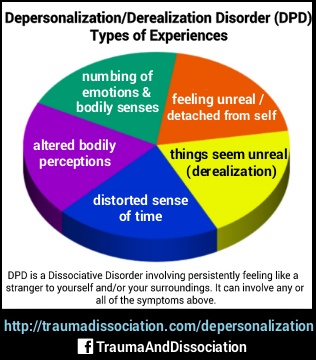

In contrast to delusional disorders and other psychotic processes, reality testing is intact. Patients suffering this condition describe their experience as if they were an outside observer of their own mental processes and actions. Individuals commonly report feeling like a robot or as if they are living a dream or a movie.

Depersonalization disorder is primarily a disturbance in the integration of perceptual experience. Maldonado, in Encyclopedia of Stress (Second Edition), 2007 Depersonalization Disorderĭepersonalization is characterized by persistent or recurrent episodes of feelings of detachment or estrangement from one's self. What kind of effect does the illness have on the patient's work, family, or financial situation? Is there a feeling of loss of control? Does the patient feel guilt about the illness? Does the patient think that he or she will die? By pondering these questions, you can learn much about patients, and patients will realize that you are interested in them as whole persons, not merely as statistics among the hospital admissions. Inquire specifically as to what the patient thinks is happening. What do the patients think is wrong with them? Do not accept merely the diagnosis. This is discussed further in Chapter 5, Mitigating Racism and Bias in Clinical Medicine.Ī good interviewing session determines what the patients comprehend about their own health problems. Such introspection enhances the self-image of the interviewer and results in the interviewer's being perceived by the patient as a more careful and compassionate human being to whom the patient can turn in a time of crisis. Inexperienced interviewers not only must learn about the patient's problems but also must gain insight into their own feelings, attitudes, and vulnerabilities. This failure to communicate weakens the doctor–patient relationship. They may eventually come to rely on the technical results and reports.

They may be irritable and pay inadequate attention to the patient's story. At the same time, clinicians may be pressed for time, overworked, and sometimes unable to cope with everyday pressures. A name tag is placed on the patient's wrist, and he or she becomes “the patient in 9W-310.” This lowers the morale of the patient even more. A patient admitted to the hospital is stripped of clothing and often of dentures, glasses, hearing aids, and other personal belongings. They may be apprehensive because they have a problem that their health care provider considers too serious to be treated on an outpatient basis. Many find themselves in a strange environment, lying naked while clothed people march in and out of the room and touch them, tell them what to do, and so forth. Patients may feel dehumanized on admission to the hospital.

Both doctor and patient may feel increasingly neglected, rejected, or abused. Clinicians may order computed tomography scans or sonograms without taking the appropriate time to speak with the patient about the tests. Health care providers may spend more time looking at a computer screen than looking at their patient. In this age of biomedical advancements, a new problem has arisen: a depersonalization of the doctor–patient relationship. Swartz MD, FACP, in Textbook of Physical Diagnosis: History and Examination, 2021 Depersonalization of the Doctor–Patient Relationship


 0 kommentar(er)
0 kommentar(er)
